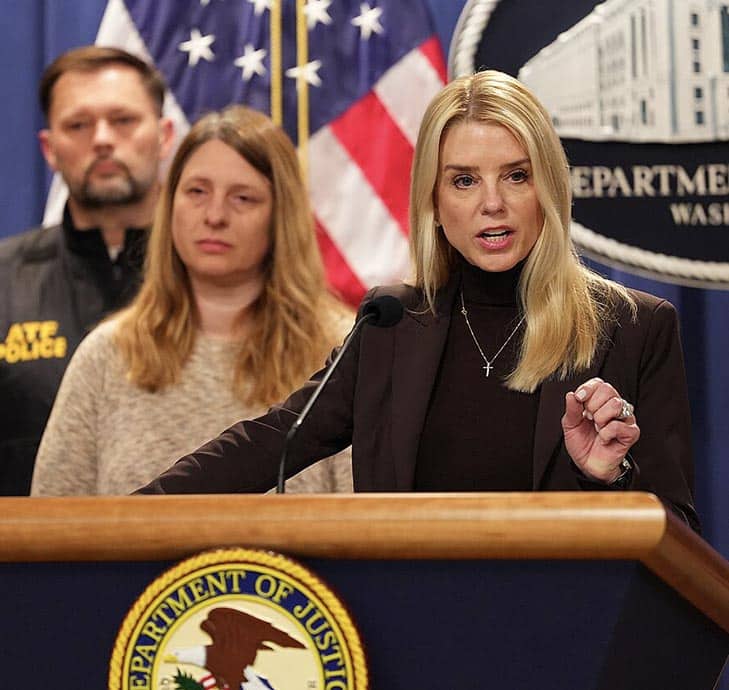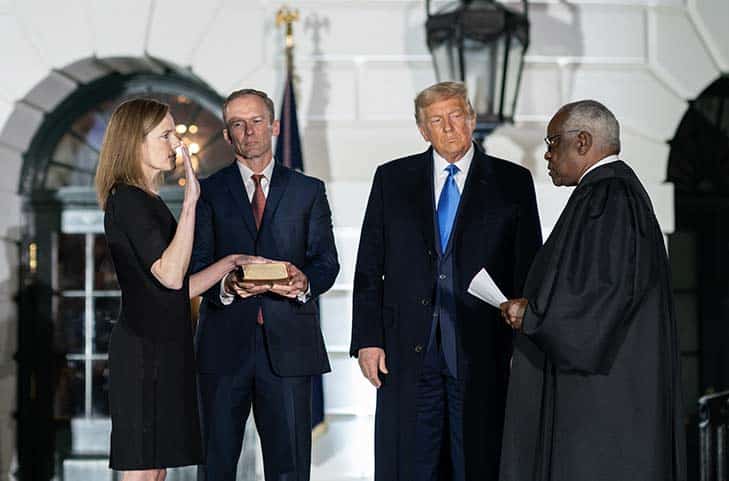The United States is facing a dramatic and consequential turning point in its legal and political landscape—one expected to reshape the balance of powers and return authority to the hands of elected officials. The formative event that set the path to this moment occurred on June 27 of this year, when the Supreme Court issued a decisive ruling, by a resounding six-to-three majority, sharply restricting the use of nationwide injunctions—a legal tool that many on the American right long viewed as a potent weapon for blocking the policies of a duly elected administration, especially those of President Donald Trump.
The ruling, authored by Justice Amy Coney Barrett, not only shifts the balance of power in favor of the executive branch but also curtails the excessive judicial intervention that had become a genuine obstacle to implementing the voters’ will. It echoes deep concerns raised by legal commentators who exposed the systematic strategy of using courts to bypass democratic election results and preserve political power despite defeats at the ballot box.
The Judiciary Versus Trump: A Campaign of Blockades
Trump’s two terms as president—the first from 2017 to 2021 and the current one, beginning in 2025—resembled a long and grueling march through a legal minefield, where the judiciary emerged as a central obstacle to carrying out a political agenda meant to represent millions of voters. Federal courts at levels below the Supreme Court, often from distinctly liberal districts, strategically deployed nationwide injunctions to freeze key presidential initiatives, effectively turning the judiciary into a veto tool against the elected executive. During Trump’s first term alone, more than 64 such injunctions were issued—a number far exceeding the total issued against all previous presidents combined, including those who governed during times of national crisis such as wars or economic turmoil. These injunctions were neither isolated nor incidental; they created a systematic and organized pattern of obstruction that frustrated not only Trump himself but also the voters who had seen his promises—such as building a border wall, economic reforms, and immigration restrictions—as a hope for real change.
To illustrate the depth of the problem and bring it to life, it is worthwhile to focus on several key examples that highlight this dynamic. One of the earliest and most famous was the travel ban announced in January 2017, shortly after Trump’s inauguration. This executive order, aimed at restricting entry from countries deemed high terror risks—such as Iran, Yemen, Lebanon, Syria, Libya, and other Middle Eastern states—was viewed by his supporters as a necessary step to bolster national security in an era of global threats. Yet within days, a single judge in Washington State—a strongly liberal jurisdiction—issued a nationwide injunction freezing the policy across the United States, arguing that it constituted a “Muslim ban,” in other words, that Trump was barring certain foreigners from entering the U.S. for racist rather than security-based reasons.
This was, of course, a political interpretation. One could agree with Trump that the entry ban stemmed from security concerns, or one could reject that view. But ultimately, it was a presidential decision, and a judge had no authority to impose his political stance by nullifying an order issued by someone elected by tens of millions of Americans to lead the world’s foremost superpower.
The judge’s ruling inevitably led to chaos at airports, mass protests, and a sense of helplessness among Trump supporters. A revised version of the order, which attempted to address criticisms, met the same fate in Hawaii, where another judge blocked it again, citing arguments of religious discrimination. Only after many months of appeals, exhausting legal battles, and massive expenses did the Supreme Court approve an adapted version in 2018. By then, however, the momentum of the policy had weakened: security threats had not vanished, but the message to the public was crystal clear—a single unelected judge, unaccountable to voters, could dictate national security policy from the bench, without regard for the broader considerations of the executive branch, such as intelligence assessments or international diplomacy.
This trend did not end with the travel ban from terror-linked countries. It expanded and intensified in other areas, especially immigration, which had been the core of Trump’s electoral promise. In 2019, for example, Trump’s attempt to terminate the DACA (Deferred Action for Childhood Arrivals) program—which shields the children of illegal immigrants from deportation and allows them to work and study in the U.S.—was blocked by a lone judge in Washington, D.C., a liberal political hub, through a nationwide injunction. The program, established by President Barack Obama in a 2012 executive order, continued in force despite Trump’s wishes, creating an absurd reality in which the judiciary dictated immigration policy in practice, disregarding the will of voters who had opposed it. Another vivid and troubling example was the 2020 “public charge” rule, designed to prevent granting green cards (work permits) to immigrants who are dependent on public assistance, such as food stamps or housing benefits. The rule, supported by many economists who viewed it as a step toward reducing the burden on taxpayers, was blocked nationwide by a judge in New York—another jurisdiction known for its liberal tilt—thereby preventing its enforcement across all 50 U.S. states.
Similar decisions emerged from other judicial districts associated with the American left—California, Alaska, and Connecticut—positioning themselves as the spearhead of resistance to Trump’s policies, often invoking broad arguments about the “human rights” of immigrants or undocumented residents, without weighing the economic or security context, or the human rights of American citizens themselves.

The Judicial Opposition Intensifies
In Donald Trump’s second term, which began on January 20, 2025, following a sweeping election victory (winning all seven swing states and the popular vote, where the number of votes alone determines the winner), the pattern of blocking his policies through judicial means not only persisted but intensified. It appeared that the judicial system had learned from his previous term and coalesced into a more organized resistance. Immediately after his inauguration, Trump signed a dramatic executive order redefining the issue of “birthright citizenship,” which pertains to foreigners who gained American citizenship solely because they were born on U.S. soil. This loophole created a phenomenon of “birth tourism,” where many non-American women deliberately gave birth in the United States to ensure their children became American citizens. Trump sought to end the cynical exploitation of this law by denying such citizenship to children of illegal immigrants. This central campaign promise garnered widespread support among voters who saw it as a step toward reducing illegal immigration.
However, within just a few days, judges in Maryland and California—once again, liberal strongholds—issued nationwide injunctions that froze the order, leading to a genuine constitutional crisis. These injunctions were supported by a coalition of 22 Democratic-led states, including New York and California, as well as immigrant rights groups like the ACLU, which argued that the order violated the 14th Amendment. Additional judicial decisions, issued with surprising speed, forced the administration to reinstate officials from President Joe Biden’s era who had been fired, restore funding to environmental and social programs that had been canceled, and even reinstate content related to gender identity on federal government websites. These actions underscored the breadth of judicial intervention—not only on immigration issues but also in education, healthcare, and culture.
A particularly striking and troubling detail—illustrating the disproportionate nature of the system’s conduct—is that five distinctly liberal districts issued 35 out of 40 nationwide injunctions blocking Trump’s agenda out of the 94 federal districts in the United States. These districts effectively dictated national policy for 330 million Americans, disregarding the will of the majority as expressed in the elections. This disproportionate influence from liberal districts, where judges appointed by Democratic presidents like Biden, Obama, and Bill Clinton form the majority, highlighted the systematic nature of the opposition, as Trump himself noted in his speeches. “They’ve issued more nationwide injunctions against me than in the entire 20th century combined,” he said. “Nearly 700 federal judges could previously block presidential policy, but now it’s actually happening, and it must stop.”
Jonathan Turley, a law professor at George Washington University, articulated this frustration sharply and in detail, writing that “judges appointed by radical Democrats have turned the judiciary into a tool of mass obstruction, using nationwide injunctions to paralyze the executive branch and nullify the president’s authority. This is ‘obstructionism’ without constitutional basis, a judicial revolution designed to neutralize Republican administrations and preserve power despite Democratic electoral losses.” In a widely discussed article among conservative commentators, Turley linked this phenomenon to a broader Democratic strategy: maintaining political power despite election losses by utilizing courts as an alternative to legislative action and as a brake on executive power. He cited specific examples from Trump’s second term, such as blocking the Treasury Secretary from accessing financial records related to immigration to prevent harm to illegal immigrants. He called this phenomenon “rule by judicial decree”—a term that gained traction in American political discourse.
The historical context Turley highlighted, combining political, legal, and social events, underscored the urgency that led Trump and his allies, including Attorney General Pam Bondi, to appeal to the Supreme Court to restore executive branch authority. These battles were not merely legal. They affected the broader public, creating deep frustration among Trump’s supporters—such as farmers in Texas suffering from illegal immigration or factory workers awaiting economic reforms—and raised fundamental questions about American democracy: Can unelected judges override the will of the voters, and what happens when the judiciary becomes a political tool? Ultimately, this decade of struggles exposed a deep systemic flaw that demanded dramatic reform to preserve constitutional principles.

Preserving the Principle of Separation of Powers
As noted, on June 27, the U.S. Supreme Court dramatically changed the rules of the game with a ruling that limits the scope of nationwide injunctions—also known as “universal injunctions”—and restores power to the executive branch. Justice Barrett, summarizing the majority opinion, ruled that such injunctions likely “exceed the equitable authority granted by Congress to federal courts” under the Judiciary Act of 1789, which has served as the foundation of the American judicial system since the time of the Founders.
This dramatic ruling did not directly address the legality of Trump’s “birthright citizenship” order, which sparked the debate. Instead, it struck down existing injunctions and instructed lower courts to limit relief to specific plaintiffs with personal legal standing, rather than imposing broad nationwide bans. This change, perceived by many as a counter-judicial revolution, was designed to prevent a single judge from dictating national policy, aligning with historical norms and the principle of separation of powers, which ensures that each branch remains within its domain without usurping the authority of the others.
Barrett’s analysis was comprehensive, grounded in a deep historical review, which determined that “there was no practice even remotely similar” to the Constitution granting federal judges the authority to nullify a U.S. president’s decisions. Barrett, appointed during Trump’s term, emphasized that even the Founders, such as James Madison and John Jay, who stressed the need for limited executive powers to prevent tyranny, never envisioned such overreaching judicial intervention. She underscored that judicial authority is restricted to “cases” and “controversies” under Article III of the Constitution, ensuring remedies are directed only to those with personal standing—i.e., direct harm—rather than extending to the entire public.
Barrett sharply criticized the dissenting opinion of Justice Ketanji Brown Jackson, joined by Justices Sonia Sotomayor and Elena Kagan, two distinctly liberal justices: “We will not elaborate on Justice Jackson’s argument, which contradicts over two hundred years of precedent… She condemns an imperial executive while embracing an imperial judiciary, creating a dangerous imbalance.” She added emphatically that “no one disputes that the executive branch must abide by the law, but the judiciary does not have unlimited authority to enforce it—sometimes the law itself prohibits such intervention to preserve democracy.”
Jackson, in her sharp dissent, argued that nationwide injunctions are essential to protect broad rights, such as those of immigrants or minorities, particularly in cases involving federal policies that affect millions. She painted a dramatic picture of “millions of people harmed without nationwide relief,” referencing historical examples like civil rights struggles in the 1960s. Barrett, in response, offered a compelling analysis, noting that “this approach creates unnecessary friction between the branches and allows judges to become de facto legislators,” advocating for a balanced framework that favors specific relief over blanket prohibitions, such as limited class-action lawsuits. Other justices supporting the majority, such as Clarence Thomas and Samuel Alito, described the ruling as “restoring power to those who chose the government through the ballot box.”
Trump and his team’s legal strategy, which led to the Supreme Court victory, was clever, calculated, and unique: the president’s team, led by experienced attorneys like Attorney General Bondi, attacked the power of the injunctions themselves rather than focusing on the substantive debate over birthright citizenship, which could have led to a loss. This procedural focus on the separation of powers and legal standing led to a broad ruling that applies to future cases. This move preserved flexibility and was seen as a strategic victory.
Rulings That Weakened the Progressive Momentum
On that fateful day in late June, the Supreme Court issued two additional rulings that bolstered the conservative trend. One upheld Tennessee’s ban on gender-affirming treatments for minors, such as surgeries or hormone therapy, stating that “the law rests on a legitimate interest in protecting youth from scientifically controversial treatments,” referencing studies on the long-term psychological risks of external interventions for adolescents who feel trapped in the body of the opposite sex. The majority opinion, which effectively granted states the freedom to decide whether to facilitate or restrict gender-affirming treatments, emphasized state autonomy in the face of federal overreach. In contrast, the dissenting opinion expressed concern that the ruling discriminates and endangers the lives of transgender youth in approximately twenty conservative states.
The other dramatic ruling that day supported parents in Maryland who challenged a school policy mandating all students to participate in classes that included books and materials related to gender identity and LGBTQ issues (e.g., books promoting acceptance of same-sex families or diverse gender identities). The parents argued that this policy violated their First Amendment right to religious freedom, as the content contradicted their religious beliefs, and they sought an “opt-out” exemption for their children from these classes.
The Supreme Court, again by a six-to-three majority, ruled in favor of the parents based on the First Amendment’s guarantee of religious freedom, particularly the right to freely exercise it. The Court further held that Maryland (through Montgomery County) could not condition the right to free public education on participation in classes that directly contradict parents’ religious beliefs. The requirement to attend such courses was deemed “coercion,” and the majority emphasized that the right to religious freedom mandates exemptions when government policy imposes a significant burden on the exercise of faith—especially when the policy fails the “compelling governmental interest” test. The Court also addressed Montgomery County’s “no opt-out” policy, which prevented parents from choosing non-participation, viewing it as a disproportionate violation of their rights.
The victory in the Supreme Court strengthened the religious rights of parents and students, aligning with Trump’s conservative base, which saw it as validation of his support for traditional families. Together, these rulings created a sense of profound change, signaling that the Supreme Court, with its conservative majority, was finally correcting historical wrongs and restoring democracy to its course. “The American Republic was not meant to be ruled by unelected judges acting as uncrowned kings,” explained Professor Turley. “Courts are not legislators; their role is to interpret laws while strictly adhering to the Constitution, not to reinvent it.”

No Time Wasted: Immediate Consequences
The three rulings sparked widespread reactions across the United States and beyond, including from President Trump, who responded with open enthusiasm. “This is a huge victory for true democracy!” he posted on X shortly after the rulings were announced. Later, he hosted a lively press conference at the White House alongside Attorney General Bondi, where he emphasized: “Americans are finally getting what they voted for at the ballot box—strong policies without obstruction from unelected judges.”
Bondi, for her part, added a legal perspective to the event: “This ruling restores the balance of power and allows us to move forward with the immigration order, fulfilling a key campaign promise.” This response was not merely rhetorical. It marked the beginning of immediate implementation, with government announcements about the gradual enforcement of the order.
The immediate consequences were felt at all levels: the Trump administration announced the phased implementation of the immigration order, transitioning to alternative class-action lawsuits to address limited legal challenges. Conservative states like Texas and Florida hailed the ruling as a “victory for state autonomy,” with Texas Governor Greg Abbott posting on X: “Finally, we can enforce immigration laws without progressive interference from New York or Washington.” In contrast, liberal states like California are planning further appeals.
The June rulings may reshape the balance of powers in the United States for the long term, like an earthquake altering the geological landscape. Limiting nationwide injunctions transfers significant authority back to the executive branch, enabling the president to implement policies more efficiently without the chronic obstruction that had become a substantial barrier to effective action. This strengthens the principle of separation of powers, positioning the judiciary as a supervisory partner rather than a primary obstacle, and aligns with the Founders’ historical calls for a proper constitutional balance, ensuring the elected branch can act without excessive interference.
On the social front, the ruling on gender-affirming treatments grants greater autonomy to states and families, resulting in a diverse patchwork of laws that reflect varied cultural values. For instance, conservative states like Tennessee can protect youth from controversial treatments, while liberal states like New York will continue to promote what they view as “equality.” The ruling will bring to the forefront fundamental issues like “federal consistency,” particularly in the military, which maintains relatively permissive policies on gender-affirming treatments and may now need to adjust its approach in light of the new ruling, or in national sports competitions, where some states allow transgender individuals to compete against women while others do not.
Economically, the rulings are expected to accelerate the implementation of various Trump reforms, including tax cuts to boost investment, deregulation of environmental policies to facilitate energy development, and infrastructure projects that will create millions of jobs. If successful, these reforms will strengthen Republican support and fund educational initiatives aligned with parental rights, such as curricula that emphasize traditional values and reduce the influence of “woke” ideology.
This Isn’t a “Threat to Democracy” in America. And in Our Case?
On the international stage, the rulings may inspire conservative governments to adopt similar measures to strengthen the executive branch, as the Netanyahu government attempted in Israel in 2023. In the eyes of Benjamin Netanyahu’s supporters and various legal scholars, the situation in Israel is far more severe than in the U.S., even before the dramatic June ruling.
Unlike the American case, Israel’s Supreme Court (sitting as the High Court of Justice, or the Supreme Court) strikes down government decisions without a written constitution or solid legal grounding, creating a “super-constitution” from its own imagination. This enables broad intervention in all areas of life—from economic legislation to national security. In Bagatz, unlike in the U.S., where the executive or legislative branches appoint judges, judges are selected by a closed committee that includes the judges themselves. It even intervenes in security matters during wartime, such as invalidating military orders against terrorist organizations—a scenario unimaginable in the United States, where courts generally refrain from addressing national security to avoid undermining the executive branch.
The U.S. Supreme Court rulings will undoubtedly serve as fertile intellectual ground for opponents of Israel’s current judicial system. Suppose the world’s greatest democracy sets clear boundaries for judicial intervention in policy matters. How could applying a similar principle—even in a milder form than the one ruled in the U.S.—be interpreted as a “threat to democracy”? After the conclusion of the Swords of Iron War and the upcoming elections, expected as of this writing to take place by the end of 2026, we will discover the answer.








